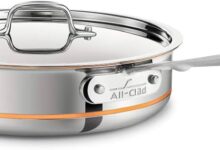All Purpose Flour Bleached Or Unbleached: Making the Right Choice for Your Baking Needs

All purpose flour can be bleached or unbleached, which refers to whether or not the flour has been chemically treated to whiten it. Bleached flour has been treated with chemicals to speed up its aging process and make it appear whiter, while unbleached flour is naturally aged over time.
Flour is a staple ingredient in baking, used in a wide range of recipes. But when it comes to choosing the right flour, you may have come across the terms “bleached” and “unbleached. ” These terms refer to the treatment process that the flour undergoes.
We will explore the differences between bleached and unbleached all purpose flour, and the impact it can have on your baking endeavors. Understanding these differences can help you make an informed decision and achieve the desired results in your baked goods.
What Is All Purpose Flour?
All purpose flour is a versatile ingredient widely used in baking recipes. It is a blend of hard and soft wheat varieties and is available in both bleached and unbleached forms. Bleached flour goes through a process where chemicals are added to whiten the flour and improve its texture. Unbleached flour, on the other hand, is not chemically treated and retains its natural off-white color.
Definition and types:
All purpose flour is a finely ground powder made from wheat, which contains gluten, a protein that provides structure to the dough. There are mainly two types of all-purpose flour: bleached and unbleached.
Common uses in baking:
All purpose flour is a staple in many baking recipes, including cakes, muffins, cookies, and bread. Its versatility makes it suitable for various culinary creations. Whether you’re making a fluffy birthday cake or a crusty loaf of bread, all purpose flour is the go-to choice for many bakers.
The Difference Between Bleached And Unbleached Flour
Bleached and unbleached flour are the two main types of all-purpose flour. Bleached flour undergoes a chemical treatment process to speed up the aging process and give it a lighter texture and color. On the other hand, unbleached flour is allowed to naturally age over time, without any chemical treatment.
Bleached flour tends to have a softer texture and a finer crumb, while unbleached flour is slightly denser and has a slightly more grainy texture. Additionally, bleached flour has a whiter color compared to unbleached flour, which has a more off-white or creamy color.
There are pros and cons to each type of flour. Bleached flour is preferred by some bakers for its ability to produce cakes and pastries with a lighter texture and higher rise. It also tends to have a longer shelf life. However, the chemical treatment involved in bleaching can affect the flavor of the flour and may cause it to lose some of its natural nutrients.
Unbleached flour, on the other hand, retains more of its natural nutrients and has a slightly nuttier flavor. It may not produce the same level of rise as bleached flour, but it is often preferred for bread baking and recipes where a denser texture is desired. However, unbleached flour may have a slightly shorter shelf life compared to bleached flour.
Factors To Consider When Choosing Flour
Factors to Consider When Choosing Flour:
Flavor and texture: The choice between bleached and unbleached all-purpose flour can greatly impact the flavor and texture of your baked goods. Bleached flour has been chemically treated to whiten and soften it, resulting in a finer texture and milder flavor. On the other hand, unbleached flour is in its natural state and retains more of its original flavor and texture. Consider choosing bleached flour for tender cakes and pastries where a light and delicate texture is desired, while unbleached flour is better suited for bread and recipes where a stronger flavor and slightly denser texture are preferred.
Nutritional value: Bleached flour may have slightly lower nutritional value compared to unbleached flour. During the bleaching process, some nutrients may be lost. However, the difference in nutritional value between the two types of flour is generally minimal and may not have a significant impact on your overall diet.
Availability and cost: Bleached flour is more widely available and commonly found in most grocery stores. It is often slightly less expensive compared to unbleached flour. However, the availability and cost of flour can vary depending on your location and the brand you choose. Consider your budget and accessibility when making your selection.
Pros Of Bleached Flour
When it comes to choosing between bleached and unbleached flour, many people wonder about the pros of bleached flour. One of the key benefits of bleached flour is its enhanced texture. Bleaching flour helps to break down the gluten strands, resulting in a lighter and softer texture in baked goods. This is particularly desirable in cakes and pastries that require a tender and delicate crumb.
Another advantage of bleached flour is its improved color. Bleached flour has a whiter appearance compared to unbleached flour, which can be appealing in certain recipes, such as white bread or biscuits. The bleaching process helps to remove pigments and impurities from the flour, resulting in a brighter and more consistent color in the finished product.
Additionally, bleached flour has an increased shelf life. The bleaching process involves the use of chemicals that help to inhibit the growth of microorganisms, extending the shelf life of the flour. This can be particularly beneficial for those who do not use flour frequently or for commercial bakeries that require longer storage periods for their products.
Cons Of Bleached Flour
Cons of Bleached Flour
Chemical Additives: One of the major concerns with bleached flour is the use of chemical additives. The bleaching process involves the use of chemicals such as chlorine dioxide, benzoyl peroxide, or azodicarbonamide. These additives help to speed up the bleaching process and create a whiter flour. However, these chemicals can remain in the flour and may pose health risks.
Potential Loss of Nutrients: Another drawback of bleached flour is that it may result in a potential loss of nutrients. The bleaching process can strip away some of the natural vitamins and minerals present in the flour, including Vitamin E and several B vitamins. This can reduce the nutritional value of the flour, making it less beneficial for consumption.
Health Concerns: Consuming bleached flour has raised some health concerns. The chemical additives used in the bleaching process have been associated with adverse health effects. For instance, chlorine dioxide has been linked to respiratory issues and benzoyl peroxide has been known to cause allergic reactions in some individuals. Additionally, the potential loss of nutrients in bleached flour may impact overall health and well-being.
Pros Of Unbleached Flour
Unbleached flour has several pros compared to its bleached counterpart. One of the key advantages is that unbleached flour is in its natural state and has not undergone any bleaching process. This means that it retains more nutrients compared to bleached flour. The natural state of unbleached flour ensures that it maintains its original composition and does not contain any chemical additives. This makes it a healthier option for individuals who prefer to consume food products that are minimally processed and free from artificial substances.
Cons Of Unbleached Flour
All-purpose flour can be categorized into two types: bleached and unbleached. While both types serve their purpose in baking, unbleached flour has a few drawbacks compared to its bleached counterpart. One of the cons of using unbleached flour is that it tends to result in a slightly denser texture in baked goods. This is because unbleached flour has a higher protein content, which can contribute to a slightly heavier finished product. Moreover, unbleached flour retains its natural off-white color, which may not be visually appealing to some bakers who prefer a lighter appearance in their baked goods. Additionally, unbleached flour has a shorter shelf life compared to bleached flour, as it contains natural oils that can turn rancid more quickly over time. Therefore, if you prioritize a lighter texture, visual appeal, and longer shelf life, you may consider using bleached flour instead.
Considerations For Different Baked Goods
All purpose flour is a staple ingredient in baking. When it comes to choosing between bleached and unbleached flour, it’s important to consider the specific baked goods you will be making. For cakes and pastries, bleached flour is often preferred to achieve a lighter texture and tender crumb. The bleaching process helps to break down the protein in the flour, resulting in a softer baked good.
On the other hand, for bread and yeast-based recipes, unbleached flour is often the go-to choice. The higher protein content in unbleached flour helps to develop gluten, which is essential for the structure and rise of bread. Unbleached flour also gives bread a slightly nuttier flavor.
For cookies and quick breads, both bleached and unbleached flour can be used depending on your preference. Bleached flour will result in a softer texture, while unbleached flour will lend a denser and chewier texture.
Personal Preferences And Dietary Restrictions
When it comes to choosing between bleached and unbleached all-purpose flour, personal preferences and dietary restrictions play a significant role. Taste preferences vary from person to person, with some individuals preferring the mild taste of bleached flour, while others enjoy the slightly nutty flavor of unbleached flour.
For those with allergies or dietary restrictions, the choice between bleached and unbleached flour becomes crucial. Bleached flour may contain additives like chlorine, which can be problematic for individuals with sensitivities or allergies. On the other hand, unbleached flour is a better option for those following a vegan or vegetarian diet, as it is not processed with animal products.
If you prefer organic and non-GMO options, unbleached flour is more likely to meet your requirements. Organic unbleached flour is made from wheat that has been grown without the use of synthetic pesticides or fertilizers. Additionally, choosing non-GMO verified flour ensures that the wheat used has not been genetically modified.
Experimentation And Recipe Adaptation
Experimenting with different types of flour can greatly impact the outcome of your recipe. Whether you choose bleached or unbleached flour, it’s important to understand the nuances and make the necessary adjustments for optimal results.
Substituting bleached flour with unbleached flour is a common switch in baking. While they both serve the same purpose, there are some key differences to consider. Bleached flour has been treated with chemicals to speed up the aging process, resulting in a finer texture and lighter color. Unbleached flour, on the other hand, is left in its natural state, retaining more of its nutrients and a slightly denser texture.
When substituting bleached flour with unbleached flour, keep in mind that unbleached flour may require a longer mixing time or additional liquid to achieve the desired consistency. It could also affect the overall flavor and appearance of the final product. It’s always best to experiment and make adjustments based on your particular recipe and personal taste preferences.
| Bleached Flour | Unbleached Flour |
|---|---|
| Treated with chemicals for a finer texture and lighter color | Natural state, retains nutrients and slightly denser texture |
| May require less mixing time and liquid | May require longer mixing time and additional liquid |
| Affects flavor and appearance | Retains more of its natural flavor and appearance |
Experimenting with different types of flour can add a unique touch to your recipes. Regardless of your choice between bleached or unbleached flour, make sure to adapt your recipes accordingly for the best possible outcome.
Final Thoughts And Recommendations
Summary of key points:
When choosing between bleached and unbleached all-purpose flour, there are a few things to consider. Firstly, bleached flour is treated with chemicals to speed up the aging process, resulting in a whiter color and softer texture. On the other hand, unbleached flour is allowed to age naturally, giving it a slightly off-white color and denser texture.
For general baking:
- For recipes with delicate flavors, such as angel food cake or sugar cookies, opt for bleached flour as it has a milder taste and a finer texture.
- Unbleached flour, on the other hand, is perfect for heartier baked goods like artisan bread or whole wheat muffins, as it adds more depth and flavor.
For health considerations:
- Unbleached flour is a better choice for health-conscious individuals, as it lacks the chemicals used in bleaching.
- However, it’s worth noting that the bleaching process does not leave residues or harmful substances in the flour.
Final thoughts and recommendations:
Ultimately, the choice between bleached and unbleached all-purpose flour depends on personal preferences, flavor profiles, and dietary considerations. Regardless of which option you choose, both types of flour are versatile and suitable for a wide range of baked goods. Experiment with different recipes to discover which works best for you. Happy baking!
Credit: www.amazon.com
Frequently Asked Questions On All Purpose Flour Bleached Or Unbleached
What Is The Difference Between Bleached And Unbleached All-purpose Flour?
Bleached flour undergoes a chemical process to whiten and soften the flour, while unbleached flour retains its natural color. Bleached flour may produce lighter baked goods, while unbleached flour may result in denser ones. However, both types can be used interchangeably in most recipes.
Is Bleached All-purpose Flour Safe To Consume?
Yes, bleached all-purpose flour is safe to consume. The bleaching process involves using harmless agents to whiten the flour. These agents are thoroughly rinsed and removed during the manufacturing process. Additionally, regulatory bodies have approved the use of these agents in food production.
Can I Use Bleached And Unbleached All-purpose Flour Interchangeably?
Yes, you can use bleached and unbleached all-purpose flour interchangeably in most recipes. However, be aware that using bleached flour may result in lighter baked goods, while using unbleached flour may yield denser ones. It’s recommended to follow the recipe’s instructions for best results.
Conclusion
To sum up, choosing between bleached and unbleached all-purpose flour depends on personal preference and dietary requirements. Bleached flour undergoes a chemical process to give it a whiter appearance and finer texture, while unbleached flour is in its natural state.
Both variations have their pros and cons, so it’s important to consider factors like taste, texture, and potential health concerns. Ultimately, experimenting with both types can help you decide which one works best for your baking needs. Remember to always read labels and opt for reputable brands when making your choice.








